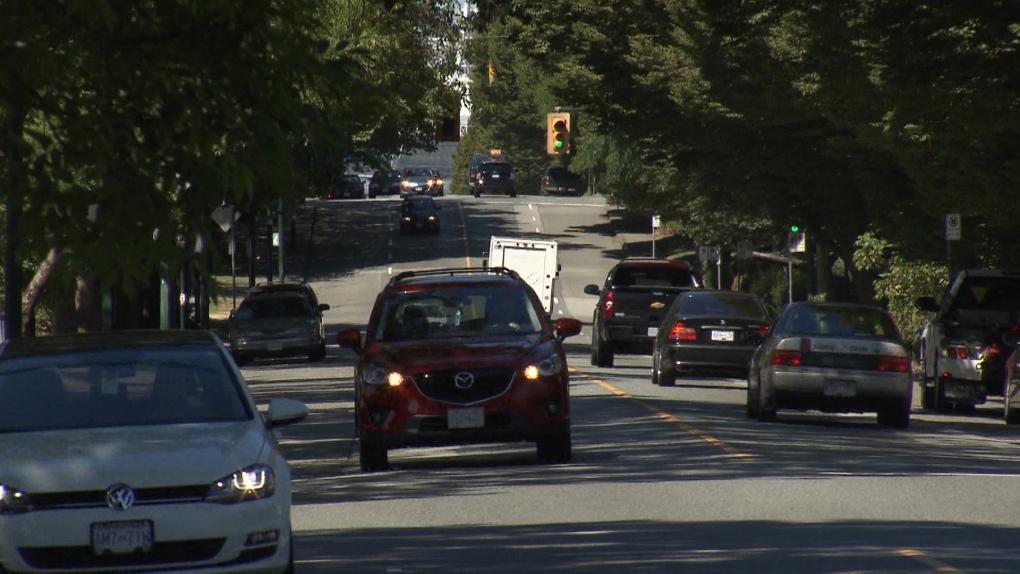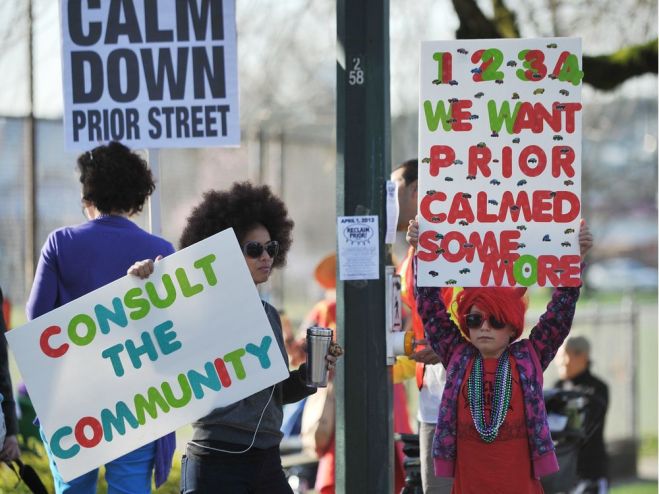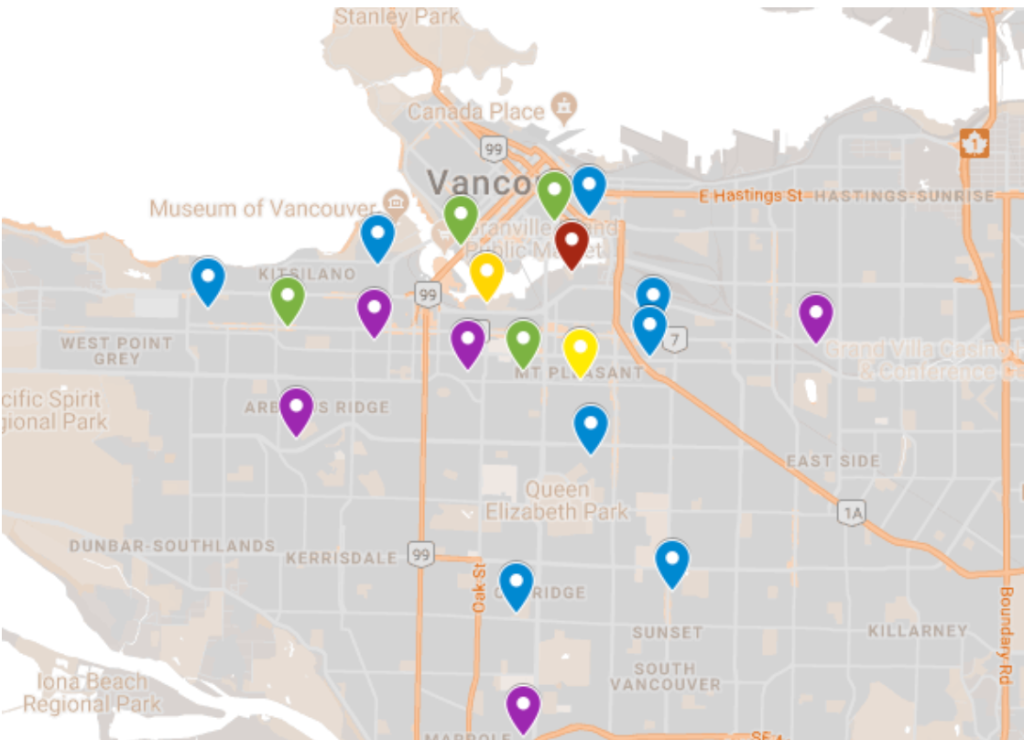If you live in Vancouver, I’d love to hear what you think about this. Please comment here or use the contact form for a less public engagement.
The media is reporting that the City of Vancouver is set to reduce Prior Street speed limits to 30km/h and reduce lanes to 1 in each direction starting Monday between Gore and Raymur for a 1-year test of traffic flows.

Photo: CTV
After I finished university I worked as an engineer at ISE Research in Port Coquitlam and I lived on Prior Street. It was fascinating and fulfilling work for a young engineer and I had the luxury of a reverse commute. Every day, I saw the clogged traffic inching into Vancouver along Prior Street, along 1st Avenue, and along the Trans Canada Highway. I saw the accidents and the thousands of cars with one driver stopped from Prior to the Port Mann bridge waiting for an accident to clear.
Things are better today than in the 1990s, but traffic flows are about to change that will make it harder to drive in and out of downtown. I recognize this is for the greater good and support it, but wonder who we are leaving behind.
This trend affects many people and sometimes the approach used to bring change needs keep the bigger picture in mind. Much thought has been put into the future of mobility in Vancouver, but our city’s past planning decisions have not been completely undone and some of the local infrastructures is simply not being delivered as promised, as expected, or as needed.
For example, ensuring public schools are within walking or safe cycling distance of the children that need them comes to mind.
Prior Street has been a heavily-used commuting link connecting the downtown and False Creek neighbourhoods to Knight Street Bridge, the Trans Canada Highway, and neighbourhoods east of Knight street for years and its existence profoundly affects the neighbourhood it defines between Clark and Main streets. Its parallel sister Hastings Street has a similar effect to the north.
During peak periods the noise and pollution of the street is a significant detriment to Strathcona residents. Off-peak, cars speed through the Strathcona stretch of Prior. With the coming decommissioning of the viaducts and construction of the new St Pauls Hospital on False Creek Flats, traffic re-routing off Prior Street was foreseeable. Here it on our doorstep.
Strathcona residents have a long history of pushing for calmer traffic on Prior Street since the Dunsmuir Viaducts was built in the 1970s despite much protest. It seems that with the renewed energy sparked by the impending arrival of St Pauls Hospital and the teardown of the Viaducts, the residents have gotten their way and convinced the city to look at the impact of calming this critical thoroughfare. I lived on Prior Street in the 1990s and understand why residents fought so hard to get traffic calmed. Traffic on Prior and Hastings streets defines the neighbourhood, effectively turning it into an island surrounded by dangerous and cantankerous flows (of cars rather than water). I agree something needs to be done to calm and reduce vehicle traffic into the city core.
I know as a whole, Vancouver residents are very active in bike activism and agree we want our city to be more green, more friendly to self-propulsion, and a less appealing place to use a car.

Photo: Vancouver Sun
The decision to change traffic flows will have consequences that need to be prioritized now that this is underway. Measures making things better for some should not make things even worse for others. Change is needed and if there are pre-requisites to a change, they need to also be addressed.
Many agree we need to reduce our climate footprint and make life better for everyone. The climate crisis is obvious and clearly getting worse. Getting cars off the road is a concrete step in the right direction and I agree we need to act now. Reducing our dependency on single-vehicle trips in our city helps this and I understand making things harder can be a stimulus for change. However, we need to be mindful of the needs of the people change affects.
I am hearing very different experiences about the role of cars and alternate transportation from people in Vancouver based on their situation. Young workers and people without families welcome further constraints on cars like slowing down Prior street. This is especially true for the many Vancouver residents around False Creek, the downtown core, and Mount Pleasant for who a car is a luxury they simply can not afford or choose to do without. They love their unicycle, their family bike, their public infrastructure and this works well for them. They have fully adapted to life without a motor vehicle in Vancouver, much like people in major metropolitan centers elsewhere have.
Replacing car lanes with bike lanes or B-line lanes makes sense to many in Vancouver, especially if their commuting distance is limited. Lyft, Uber, or Car To Go are here to address their occasional need go further afield and this works for them.
However, many parents of younger children hold a different view. They tell me about a significantly different daily reality in which they have no choice but to count on a car for All Things Family. Families without a car tell me they are significantly impacted by the location of services aimed at children in our city and by our city planners failing to take mobility into account. They tell me not having a car significantly reduces their children’s access to extracurricular activities until the end of elementary school.
Parents of elementary school kids have been telling me, and this has been my own experience, that if they have to pick up their child from school or home to take them to an activity they very often need a car because they see no other choice in a city where activities for children are not available in the neighbourhoods where they live. They tell me that although they intended never to own a car again in the past, the layout of our city forced them to buy one again despite living in the centre of Vancouver. One parent told me of the irony of having to buy a car when her olympic-village co-op came without a parking spot – because planning simply did not consider the needs of families with K-7 children in mind. Now the family has the problem of finding parking in a city that deprioritized car parking spots in new construction, all because there is noneighbourhood school to attend.
They tell me that they are impacted by the congestion we see worsening despite shrinking traffic flows within our city. They tell me that they feel trapped because past decisions by city planners force them into their cars today. They ask for more transit infrastucture to get them to the places they need to go, and that this means the whole city, not just the commuting routes.

Schools attended by Olympic Village Students, as reported by parents advocating for the construction of long-promised Olympic Village elementary school.
Image: Olympic Village School
Olympic Village parents face sending their children 20,30 blocks from their neighbourhood because the promised school was never delivered and have to drive them there despite of all the false promises made to them about walking scores and livability indexes that ignore the ability to get their children into local schools and activities. K-7 students from Olympic Village are spread to the four winds by the Vancouver School Board and the BC Ministry of Education’s prioritizations. Their neighbourhood has a near-magical walking score but there is no public school with space their children can walk to.

Yaletown families who can’t get their child into deliberately-built-so-tiny Elsie Roy or never-let-your-kids-out-of-sight CrossTown Elementary schools face a similar problem with the looming tear down of Lord Robers Annex and a commute to North West Coal Harbour waterfront, crossing the entire Vancouver Business District to the future Coal Harbour Elementary, at Broughton and Hastings during rush hour in two round trips.

Photo: Daily Hive
These parents tell me that although they ironically live in neighbourhoods with the highest walking scores of our city, their children can’t get into local programs or schools. Their child’s school too often lies on one end of town and their child’s activities on another because services are not located in their own neighbourhoods but at car-centric locations such as Granville Island (Ballet, arts), Hill Crest (Hockey, swimming, gymnastics), Point Grey (Gymnastics), and the myriad church basements and neighbourhood houses peppered unfeasibly far from major transit hubs for an elementary school child to navigate easily. Remember, also, that in BC children under 10 MUST be under the supervision of someone older than 12.
Many tell me the only way they know how to navigate our city is with a car because of the planning decisions that allowed this to happen. They welcome improvement but need the new infrastructure to be put in place before they can stop relying on their car.
They tell me removing or slowing down arterial roads without taking the needs of families into account will make their lives harder, not better. Some remind me that because they maintain and fund their car, they can not afford transit when it IS sensible as the funds for a pass are already committed to the family car.
Personally, I agree with Olympic Village parents and I share their frustration.
I believe we must prioritize implementing the transit infrastructure needed to get us out of our cars before we change traffic flows. I believe we need our cities to work with non-profits and for-profit service providers to ensure public transit safely links services to neighbourhoods. I believe that without mobility and neighbourhood infrastructure planning being done together, trying to force people onto public transit comes closer to coercion of the powerless rather than implementing good planning for greener, better cities.
What do you think? How do you feel our city and our region should prioritize funding for mobility that would best meet your needs? How do changing traffic flows in our city affect you today, and what direction would YOU like to see our city and our province choose on this issue?
I would really like to know what you think.
Leave a comment